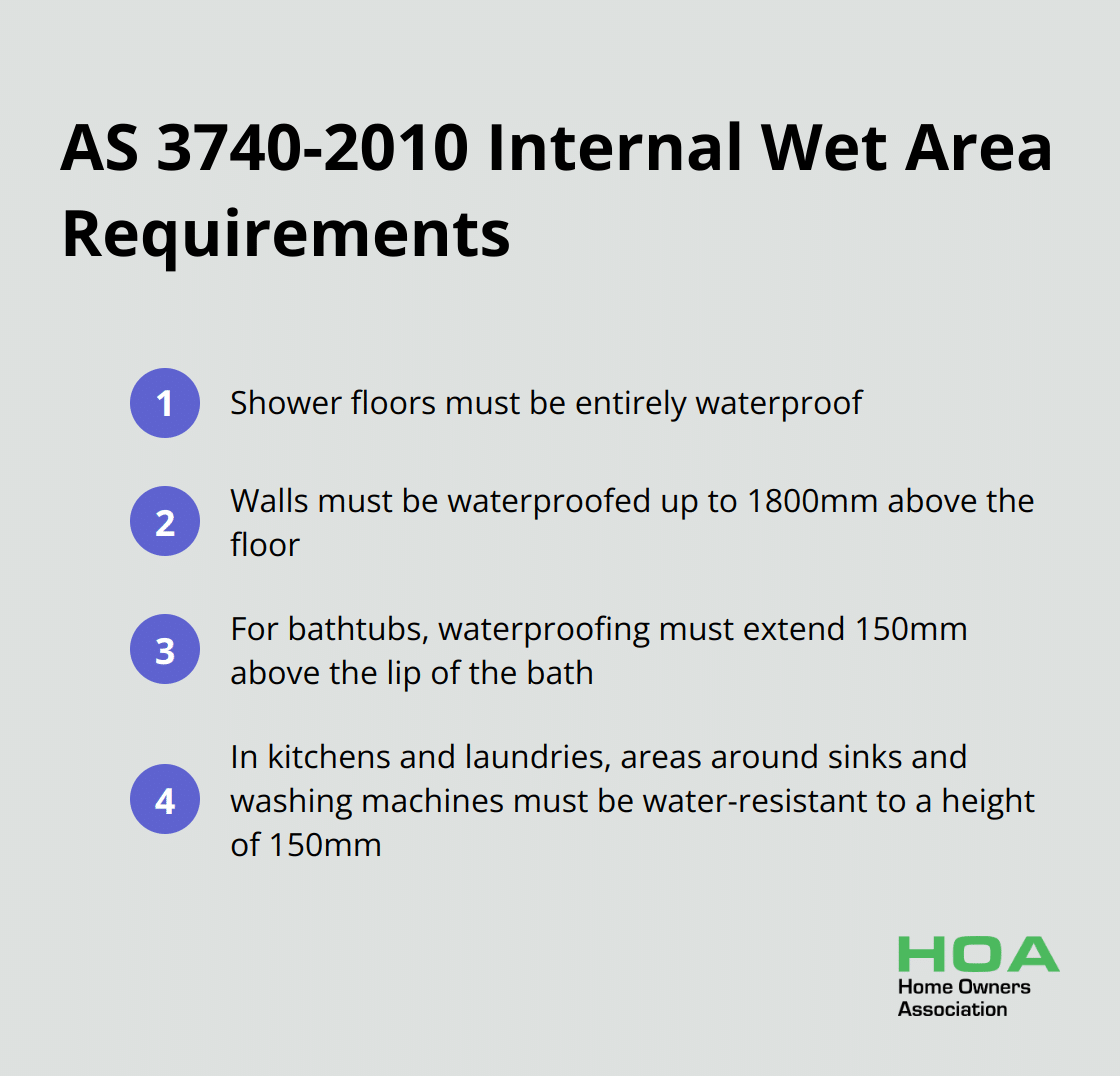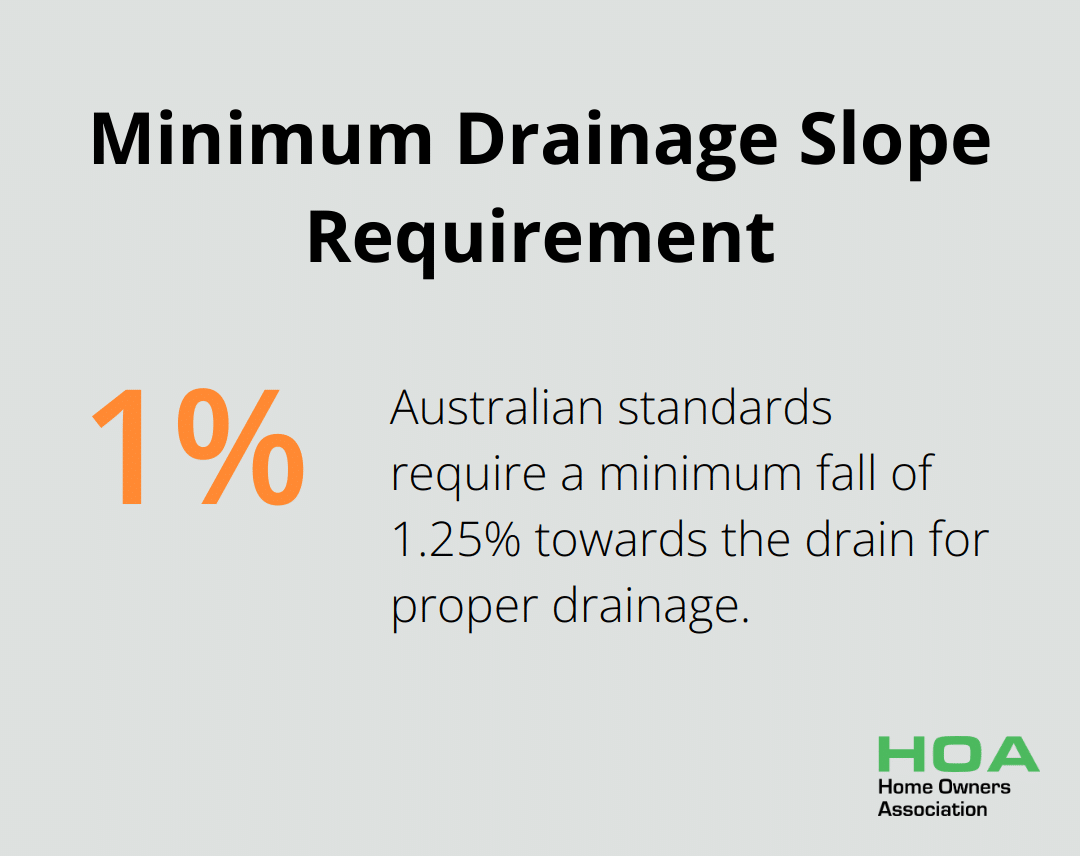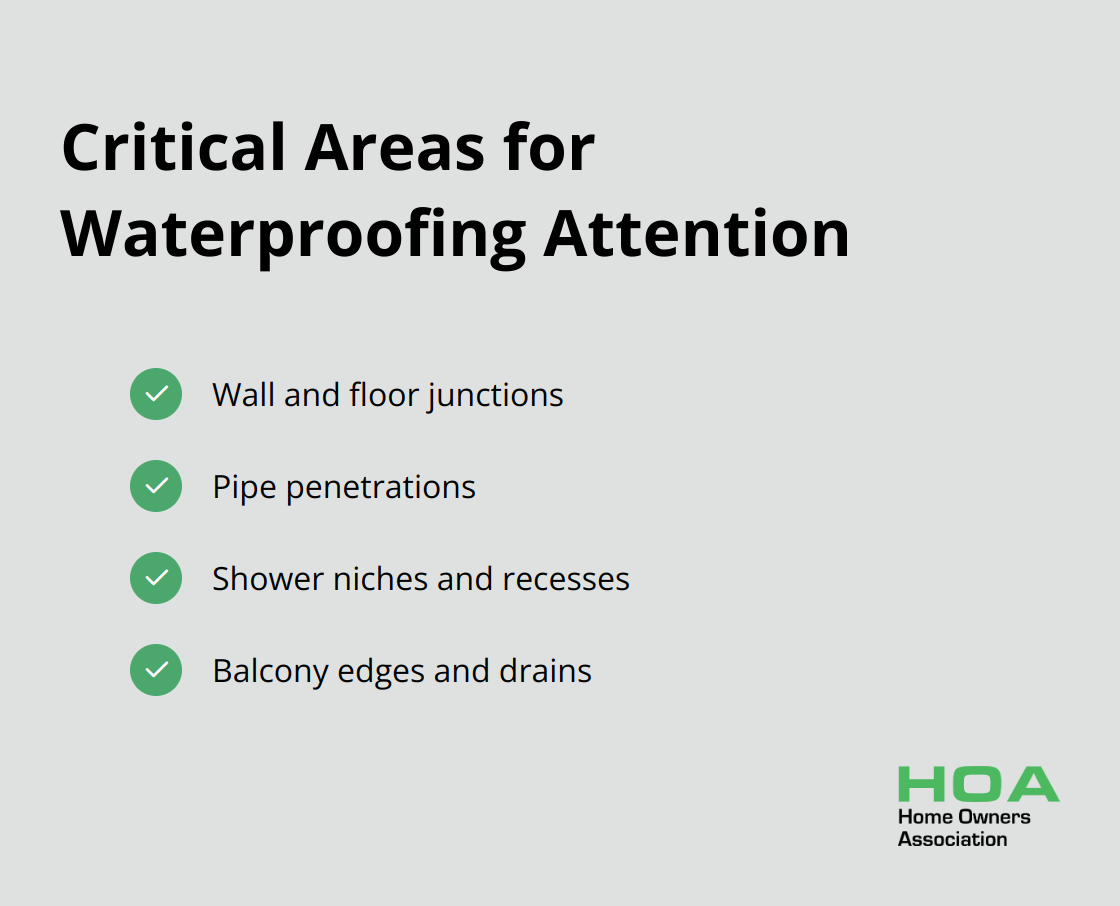
At Home Owners Association, we understand the critical importance of proper waterproofing in Australian homes.
Waterproofing Australian standards are designed to protect buildings from water damage and ensure long-lasting structural integrity.
This blog post will guide you through the essential techniques and common pitfalls in meeting these standards, helping you safeguard your property against moisture-related issues.
Understanding Australian Waterproofing Standards
Key Standards: AS 3740-2010 and AS 4654.2-2012
Australian waterproofing standards protect buildings from water damage and ensure structural integrity. The two main standards are AS 3740-2010 for internal wet areas and AS 4654.2-2012 for external waterproofing.
Internal Wet Area Requirements
AS 3740-2010 sets out the requirements for the materials, design and installation of waterproofing for domestic wet areas. This standard mandates:
- Shower floors must be entirely waterproof
- Walls must be waterproofed up to 1800mm above the floor
- For bathtubs, waterproofing must extend 150mm above the lip of the bath
- In kitchens and laundries, areas around sinks and washing machines must be water-resistant to a height of 150mm
These requirements help prevent water damage to cabinets and surrounding structures (a common issue in many homes).

External Waterproofing Specifications
AS 4654.2-2012 addresses external waterproofing for balconies, rooftops, and other exposed areas. This standard requires:
- A minimum fall of 1:100 for drainage
- Specific membrane thickness based on the area’s exposure level
- Full waterproofing of balcony floors with an upturn of at least 100mm on all walls
- Complete waterproofing of rooftops with proper drainage systems to prevent water pooling
Compliance and Testing
Meeting these standards involves more than following guidelines-it requires quality assurance. The standards specify testing methods to verify waterproofing effectiveness. Flood testing, for example, often checks for leaks in wet areas.
Working with licensed professionals who understand these standards thoroughly can save homeowners thousands in potential repair costs. While DIY projects might seem appealing, waterproofing demands expert knowledge. Incorrect application can result in severe water damage, mould growth, and structural issues.
As we move forward, let’s explore the essential waterproofing techniques that professionals use to meet these stringent Australian standards.
Mastering Waterproofing Techniques
Waterproofing requires precision and expertise. Proper waterproofing can save homeowners thousands in potential repair costs. Let’s explore the essential techniques that professionals use to meet Australian standards.
Membrane Selection and Application
The selection of the appropriate waterproofing membrane is a key step. For internal wet areas, professionals often prefer liquid-applied membranes due to their seamless application and flexibility. These membranes (typically made of polyurethane or acrylic) form a continuous barrier against water penetration.
External areas like balconies and rooftops usually require sheet membranes. These come in various materials such as bitumen-modified polyurethane or TPO (Thermoplastic Polyolefin). The choice depends on factors like UV resistance and expected foot traffic.
Application techniques vary, but proper surface preparation is universal. This includes cleaning, repairing cracks, and priming the surface. Professionals apply membranes in multiple coats, ensuring each layer fully cures before the next application.
Sealing Joints and Penetrations
Joints and penetrations represent vulnerable points in any waterproofing system. In shower areas, for example, the junction between the floor and wall requires special attention. Professionals use reinforcing fabrics or bond-breakers at these points to allow for movement without compromising the waterproof seal.
For pipe penetrations, pre-formed flanges or collars integrate with the membrane to create a watertight seal around the pipe. It’s important to follow manufacturer specifications for the correct use of sealants and adhesives.
In external areas, expansion joints require flexible sealants that can accommodate building movement. Silicone-based sealants are popular for their durability and elasticity. However, the choice of sealant must be compatible with the membrane material to ensure long-term effectiveness.
Effective Drainage Implementation
Proper drainage is as important as the waterproofing membrane itself. Australian standards require a minimum fall of 1:80 towards the drain. This slope ensures water doesn’t pool on the surface, reducing the risk of leaks and water damage.

For balconies and rooftops, drainage systems often include grates and channels to direct water away from the building. The placement of these drainage points is critical and should be planned in conjunction with the overall waterproofing strategy.
Professionals also pay attention to overflow provisions, especially in areas prone to heavy rainfall. This might include additional drainage points or raised thresholds to prevent water ingress during extreme weather events.
The complexity of materials and application techniques, combined with the potential consequences of failure, make it essential to engage licensed professionals for all waterproofing work. In the next section, we’ll explore common waterproofing mistakes and how to avoid them, ensuring your project meets Australian standards and provides long-lasting protection.
Avoiding Costly Waterproofing Errors
Inadequate Surface Preparation
Surface preparation is a critical step in waterproofing. Waterproofing defects caused by poor design and construction practices can be minimised through the introduction of adequate performance standards. To prevent this, you must clean, dry, and remove all contaminants from the surface. Fix any cracks or imperfections before you apply the waterproofing membrane. Use appropriate primers to enhance adhesion. This process takes time but ensures long-lasting results.
Incorrect Product Selection
Choosing the wrong waterproofing product for a specific application can lead to premature failure. For example, using a product designed for internal wet areas on an external balcony will not provide adequate protection. Always select products that comply with Australian standards and suit the specific area you’re waterproofing. Consider factors such as UV exposure, foot traffic, and substrate type when making your selection. If you’re uncertain, consult a waterproofing specialist or the product manufacturer.
Overlooking Critical Details
Many waterproofing failures occur at joints, corners, and penetrations. Insurance statistics have shown the highest number of waterproofing failures are balconies, terraces, rooftops in high rise dwellings. Pay extra attention to:

- Wall and floor junctions
- Pipe penetrations
- Shower niches and recesses
- Balcony edges and drains
Use reinforcing fabrics or pre-formed components designed for these areas. Ensure that the membrane is continuous and well-adhered at all points.
Poor Workmanship
Rushed or careless application of waterproofing materials can compromise the entire system. This includes applying membranes too thinly, not allowing proper curing time between coats, or failing to follow manufacturer instructions. Professional waterproofers (like those recommended by Home Owners Association) understand the importance of meticulous application and adhere to best practices.
Neglecting Maintenance
Even the best waterproofing systems require periodic maintenance. Ignoring small issues can lead to significant problems over time. Regular inspections (at least annually) can identify potential weak points before they become major issues. Look for signs of wear, cracks in sealants, or any areas where water might penetrate. Address these problems promptly to maintain the integrity of your waterproofing system.
Final Thoughts
Australian waterproofing standards provide a comprehensive framework for effective waterproofing in both internal and external areas. These standards protect properties from water damage, mould growth, and structural issues that often result from inadequate waterproofing. Proper waterproofing preserves the structural integrity of your property, prevents costly repairs, and maintains a healthy living environment.
We recommend working with licensed professionals who understand the Waterproofing Australian Standard. These experts will select appropriate materials, apply them correctly, and address critical areas prone to water ingress. Regular inspections and maintenance will identify and address any issues before they escalate into major problems.
Home Owners Association helps Melbourne homeowners navigate the complexities of home improvement projects, including waterproofing. Our members access trade pricing, expert advice, and educational resources (ensuring their waterproofing projects meet the highest standards of quality and compliance). You invest in the long-term protection and value of your home when you prioritise proper waterproofing and stay informed about Australian standards.





